Brief
As the US property and casualty (P&C) insurance market has matured, two models now dominate: the acquirers and the retainers of customers. Bain & Company conducted surveys through Research Now of nearly 26,500 US P&C consumers and almost 3,600 consumers of auto insurance. The surveys show that it’s very difficult for a carrier to excel in both endeavors. Success hinges on selecting the right customer segments, offering them a tailored proposition, then delighting them with innovative products and superior service at the key moments of truth. Our surveys serve as a guide to raising performance in acquisition and retention by earning customers’ loyalty. And loyalty, in turn, will create better economics, as customers who are promoters of their carrier are worth seven times more in lifetime value than those who are detractors.
Many US personal lines P&C carriers must feel like Alice in Wonderland, running flat out with barely any forward motion. With population growth in the US at just 0.7%, carriers have seen slow overall growth—just 2.7% over the past five years in net premiums written, totaling $256 billion and split roughly 70% and 30%, respectively, between auto and home policies, according to SNL Financial. Household growth spurred a 5% increase in home premiums, outpacing the slight 1.9% rise in auto premiums, as the number of vehicles on the road was flat.
As carriers seek to improve their growth rates, they rely on three main methods: acquisition, retention and, related to retention, cross-selling. Performance in each of these areas can be substantially improved by a systematic program to earn customers’ goodwill, creating more promoters and eliminating detractors in the customer base. Bain’s analysis of survey responses shows how this happens.
Performance on loyalty, acquisition, retention and cross-selling varies widely among insurers—and only a few companies excel at more than one dimension. The survey measured loyalty by calculating the Net Promoter ScoreSM (NPS®) for each insurance company. NPS is derived from responses to this question: On a zero-to-10 scale, how likely are you to recommend your insurer to a friend or a colleague? Depending on the score respondents gave, they were classified as promoters (9–10), passives (7–8) or detractors (0–6). NPS is the percentage of promoters minus the percentage of detractors.
The average NPS of the largest providers is 30%, 10 points higher than in 2012. This surge confirms that more companies have acknowledged the benefits of earning loyalty and have made solid progress. Scores vary widely among carriers. USAA, a long-time loyalty leader, ranks far ahead of the pack at 76% (see Figure 1).
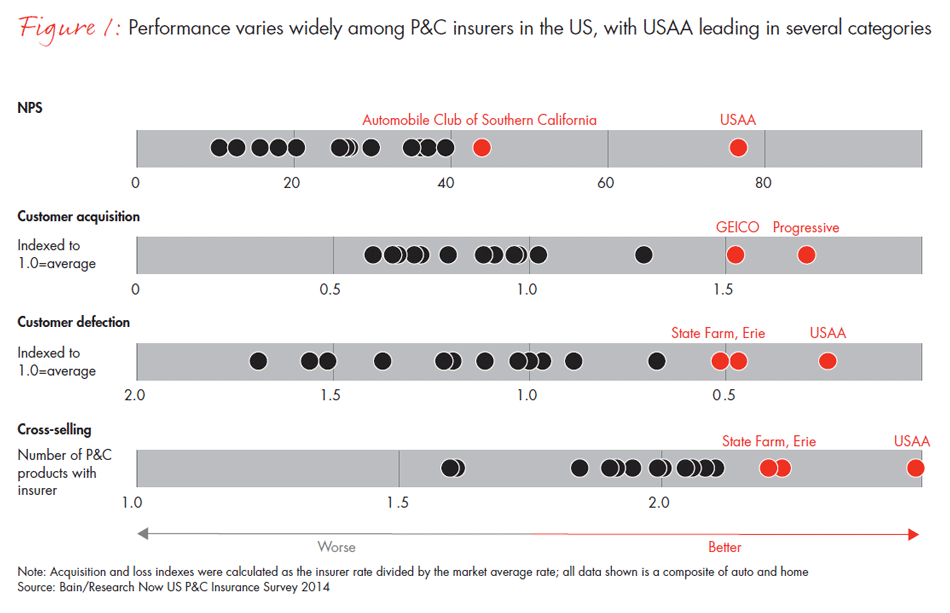
Very few carriers excel in both acquisition and retention (see Figure 2). That’s true for several reasons. Acquisition leaders tend to attract customers who are highly price-sensitive—and thus more likely to defect when they are presented with a lower-priced offer. Their customers tend to be younger, lower-income and have fewer insurance needs (see Figure 3). These companies spend more on advertising and skew toward direct distribution channels, such as online and contact centers (see Figure 4).
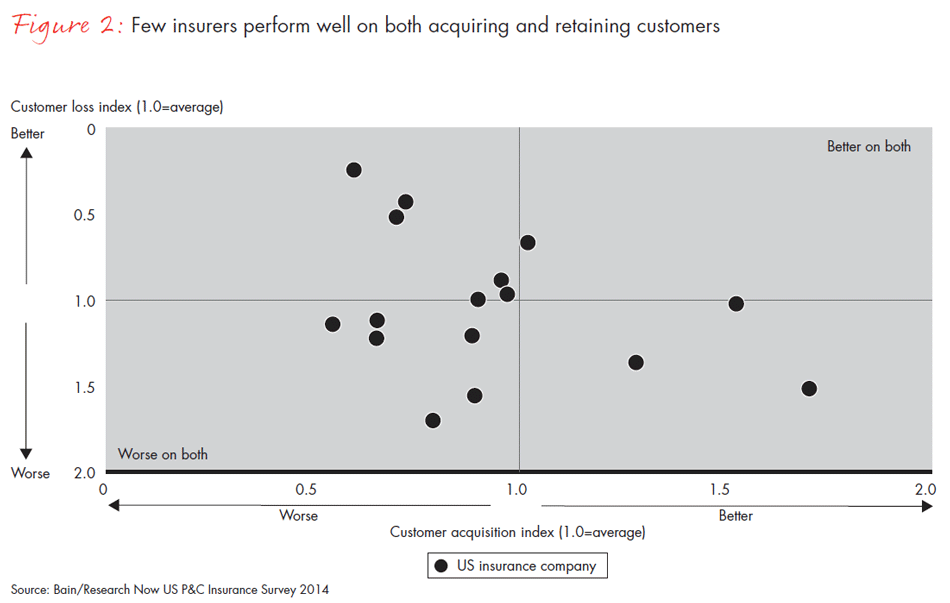
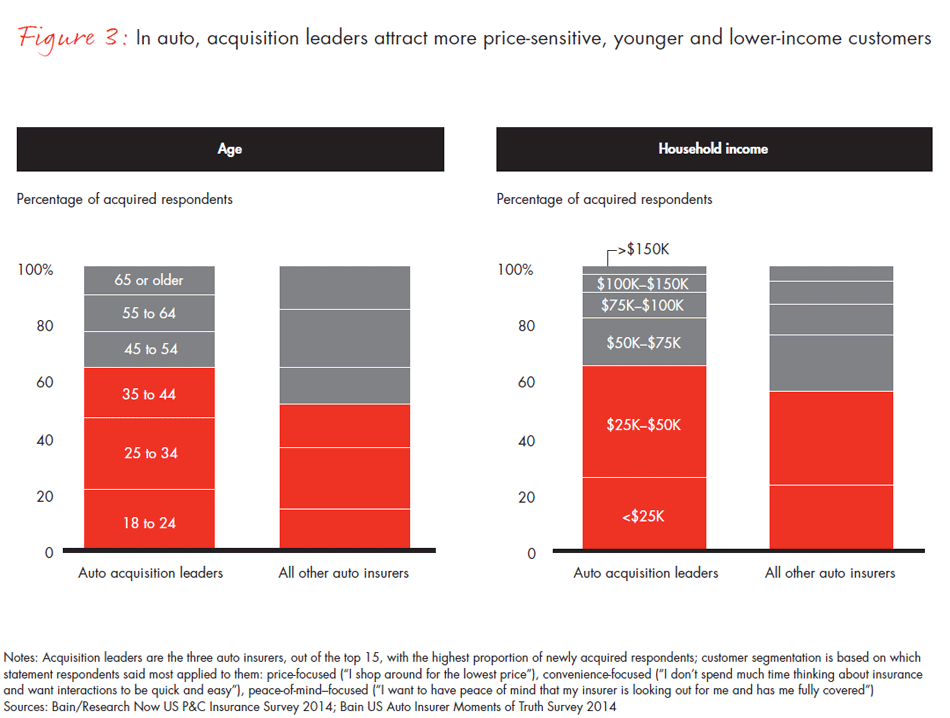
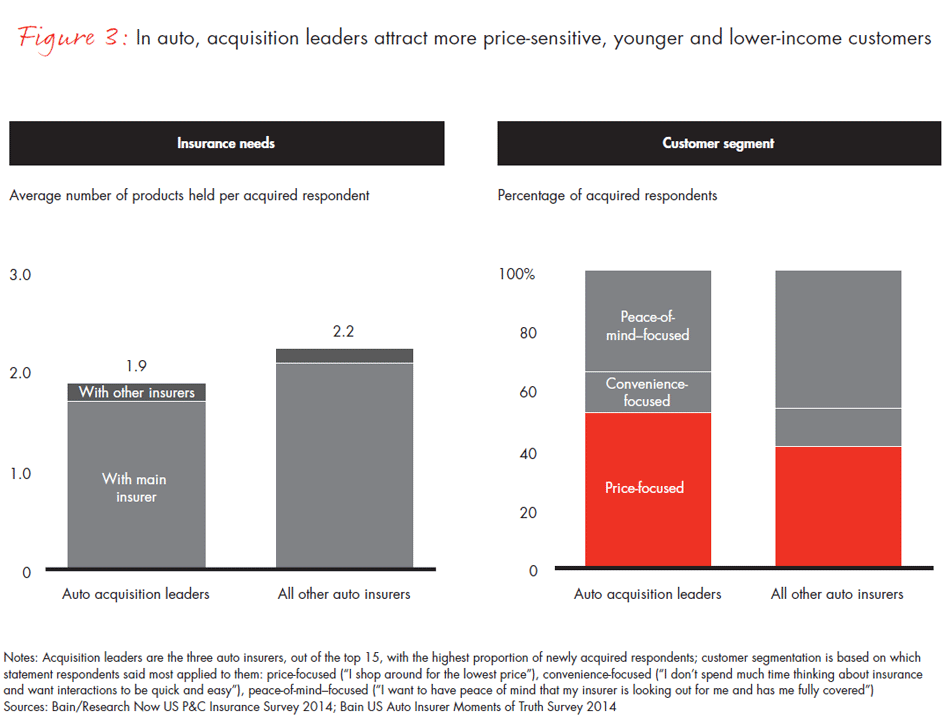
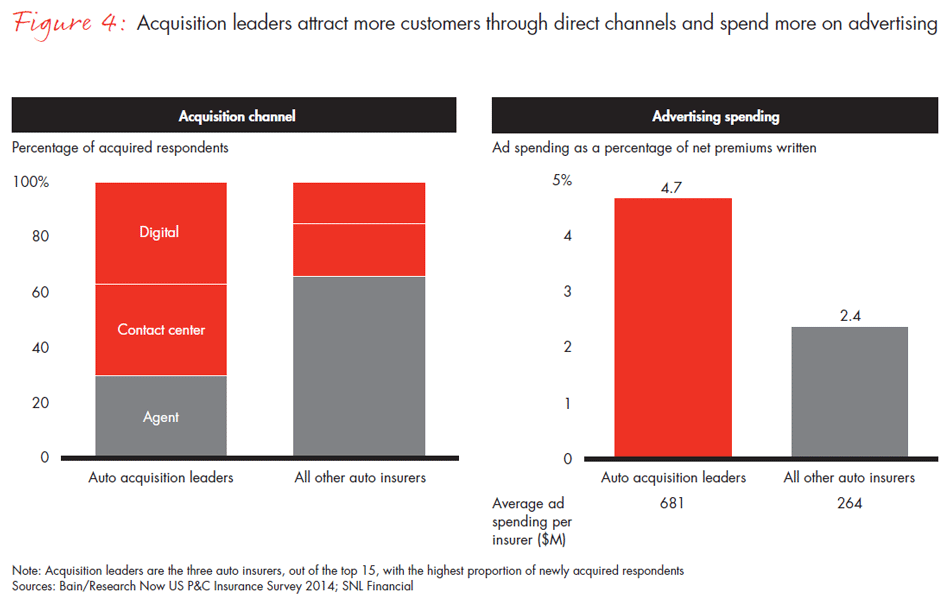
By contrast, companies that lead in retention have a greater share of people in their customer base who value peace of mind. Their customers also tend to be less price-sensitive, older, more affluent and have more complex insurance needs (see Figure 5).
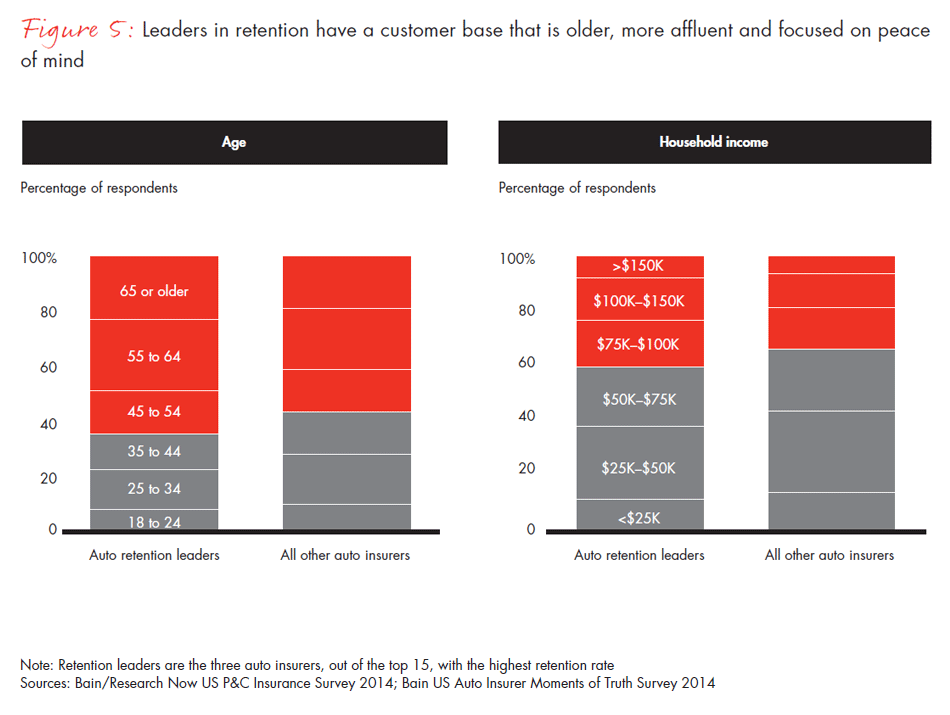
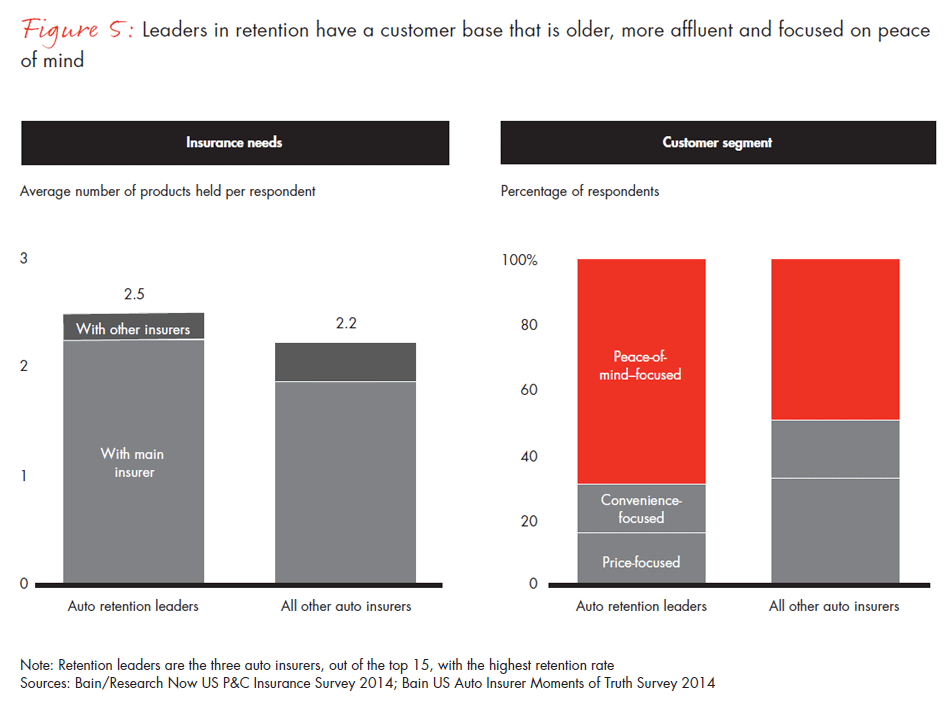
When it comes to acquisition, our survey suggests that demographics present a barrier to profitable growth. Few new customers are entering the market: Last year, it was just 1% in auto and 4% in home, for a total 2% in P&C. Most acquired customers comprise people who switch from an insurer’s competitors, and the rate of switching is somewhat higher for auto than for home—8% and 5%, respectively.
Price trumps other factors for most new customers, as seen in most advertising. Customers report that they buy home and auto insurance primarily based on price, followed by the carrier’s reputation. Two-thirds of respondents shop at more than one provider, and the share is even higher, 84%, for price-sensitive customers.
The industry has engaged in an advertising arms race over the past few years—and not just on television and in print. “Insurance” was the most expensive keyword in Google AdWords in 2011, according to WordStream. State Farm and Progressive each spent more than $43 million advertising on Google that year—more than online auction site eBay spent, though less than retailer Amazon. The advertising arms race has heightened familiarity with large insurers; much of the population has been exposed to Progressive’s Flo, GEICO’s Gecko and Allstate’s Mayhem.
The payoff is clear: Advertising spending directly correlates with customer acquisition rates. The top performers in acquisition spend 50% more than average on advertising per customer.
Most P&C insurance ads convey one of two themes: low price or peace of mind. A few ad campaigns emphasize convenience, and some contain a mix of those three themes. Acquisition leaders, though, maintain a drumbeat of price-based themes. Despite the high cost of continued customer churn, some carriers, such as GEICO, have chosen to become efficient acquisition engines.
Customers defect because of a lower-priced offer elsewhere and poor service. Customers most frequently cite price, followed by poor service or claims handling, as a reason (in a carrier’s control) for leaving their carrier. Of those who lapse because of price, more than half move to a carrier with which they save less than 20% on their premium and about one-quarter save 10% or less. Clearly, it doesn’t take much to prompt a price-sensitive person to switch.
This dynamic applies more to auto than home coverage, where it’s more difficult to make apples-to-apples price comparisons across carriers, and where the right product and reputation play a greater role. Indeed, defection on home coverage is lower across the board.
Defection rates run higher among customers who are young and lower-income, have fewer insurance needs and use only digital channels. With this profile making up the bulk of new customers for companies that lead in acquisition, it’s not surprising that these carriers find it hard to retain their customers.
Retention runs higher for the opposite profile and for customers who tend toward heavier use of live channels such as call centers or agents.
Earning loyalty increases retention and leads to better economics. NPS correlates strongly with higher rates of retention (see Figure 6). Customers who are promoters stay longer and buy more products with their primary carrier, and they make more referrals to friends and colleagues (see Figure 7).
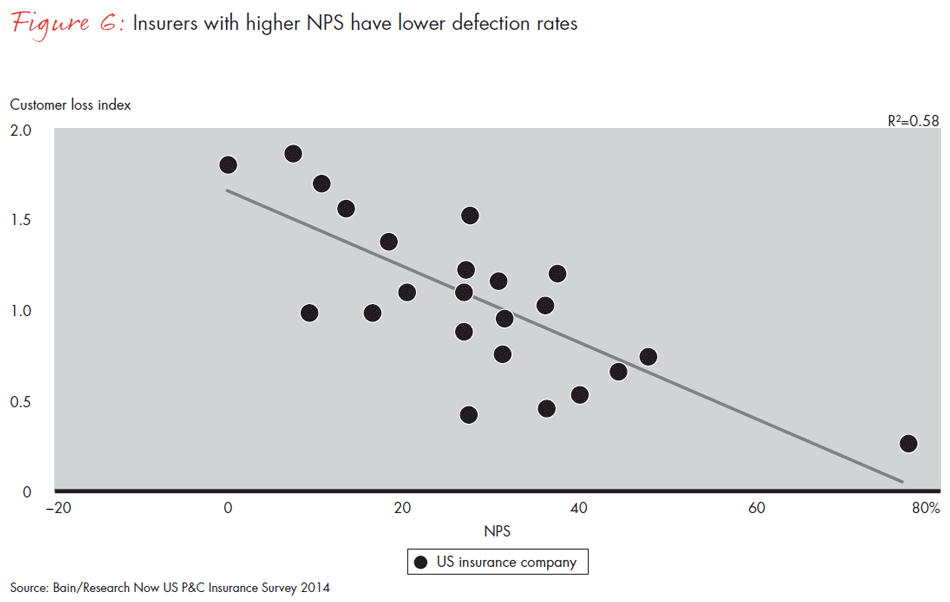
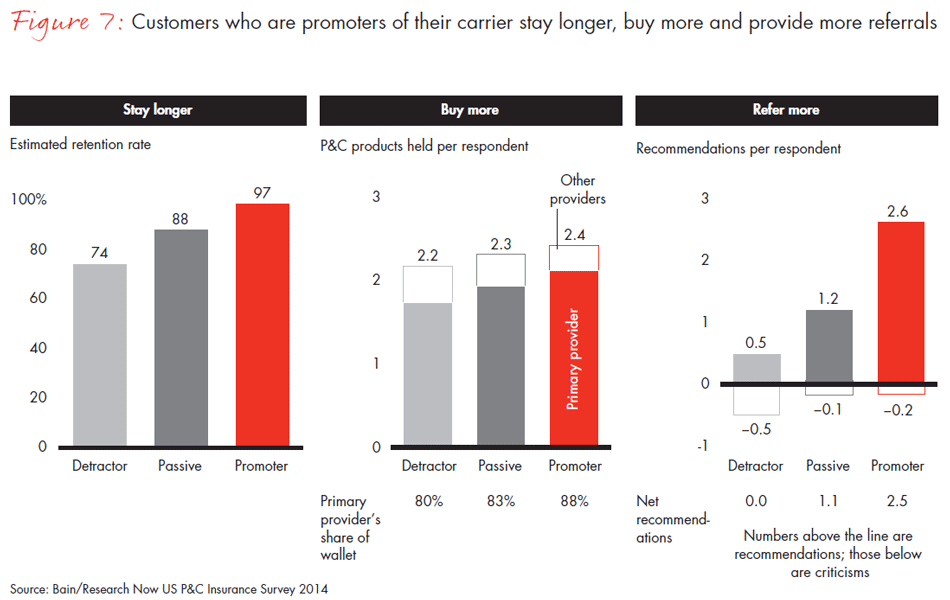
As a result, promoters are worth almost three times more in lifetime value than passive customers and nearly seven times more than detractors. And greater retention accounts for about three-quarters of that additional value (see Figure 8).
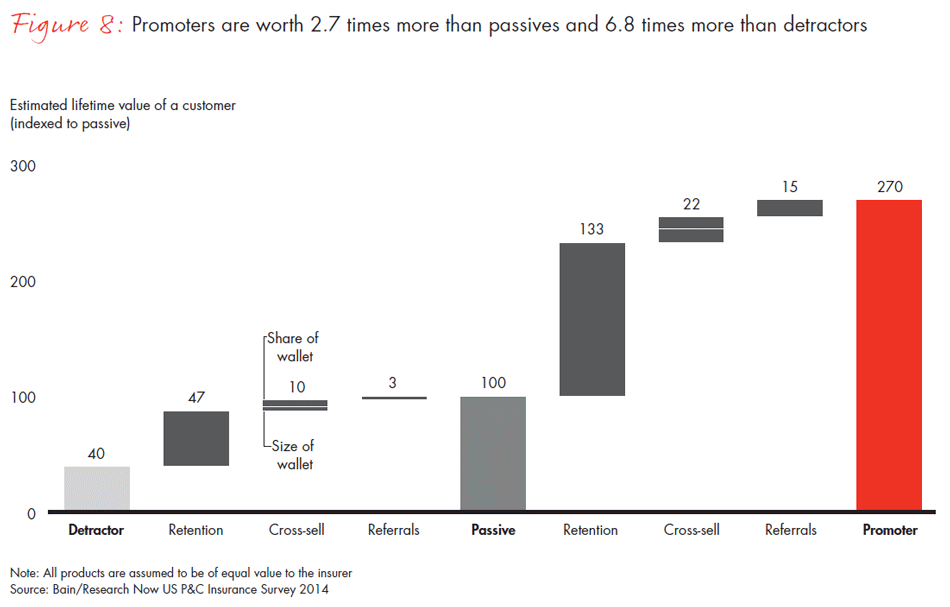
One important nuance in the bid to make loyalty pay: Our analysis in Figure 8 clearly shows that inclining a passive customer to become a promoter is roughly three times as valuable as convincing a detractor to become a passive. It’s more important to delight customers through, say, a superior claims experience than to simply avoid complaints. And that insight implies the need for a whole series of activities, processes and metrics to support the goal of delighting at key moments of truth.
Our survey respondents mentioned price and service most frequently in their comments about their primary carrier (see Figure 9). But of the types of interactions customers have with their carrier, claims events have the biggest influence on NPS (see Figure 10). With claims events so rare, however, the route to earning greater loyalty involves creating differentiated services in other areas, even though insurance is a low-touch industry.
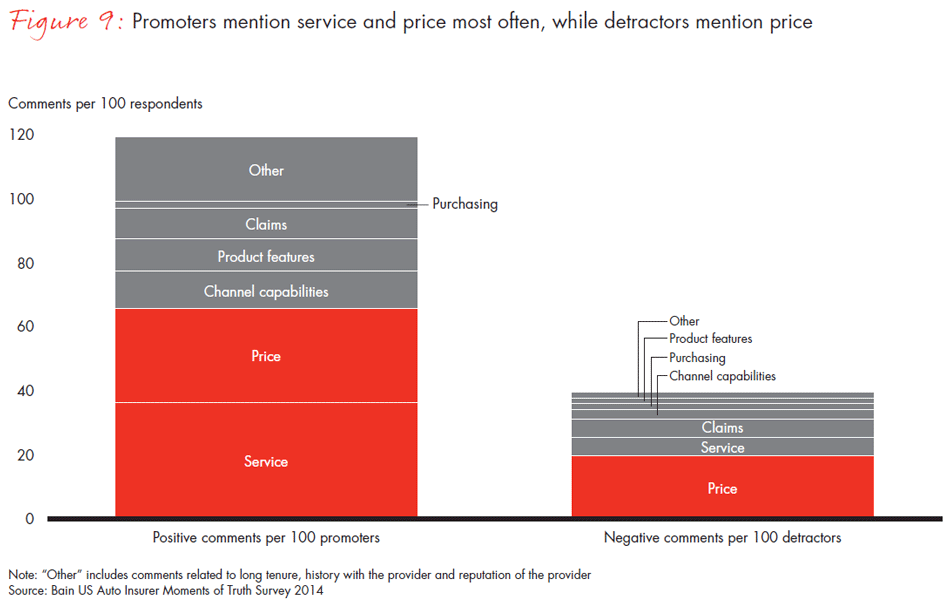
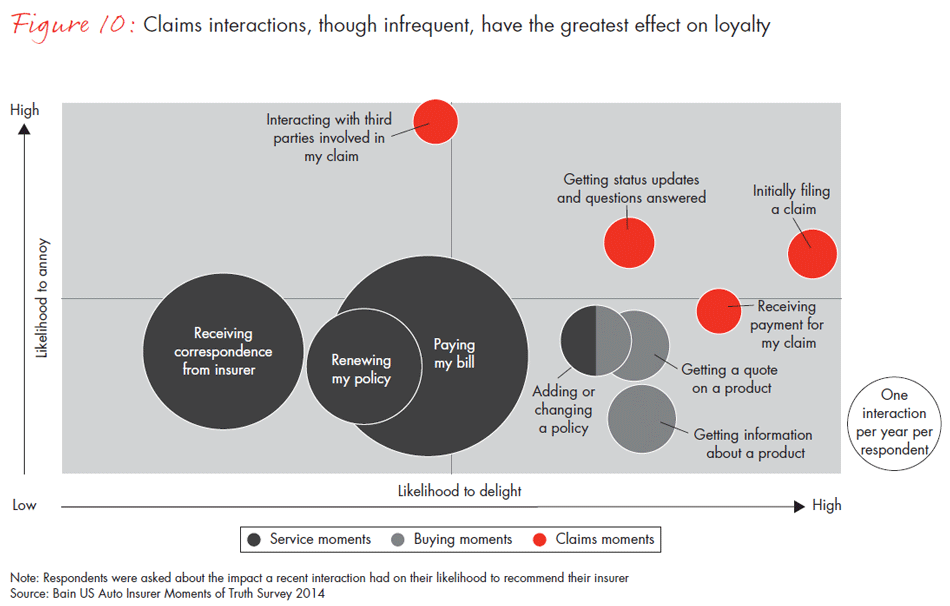
Not surprisingly, loyalty leaders have a customer profile similar to retention leaders. Their customers are older, have higher incomes and more insurance needs. They also value peace of mind more than price.
In addition, loyalty leaders tend to outperform on many dimensions: price, product and customers’ experience of their services and claims. They tend to interact with customers through multiple channels, including those that are higher-touch.
Leaders in cross-selling have higher NPS, longer customer tenures and favorable demographics. Proficiency in cross-selling offers other routes to growth: directly, by selling more products per customer, and indirectly, as customers with more products stay longer. On average, customers have two P&C products with their primary provider and give that provider an 85% share of their insurance wallet. But the leaders in cross-selling get 2.5 products and 90% of the wallet. Customers who give their primary carrier a greater share of their wallet tend to have higher loyalty and longer tenures, and they care more about having peace of mind (see Figure 11).
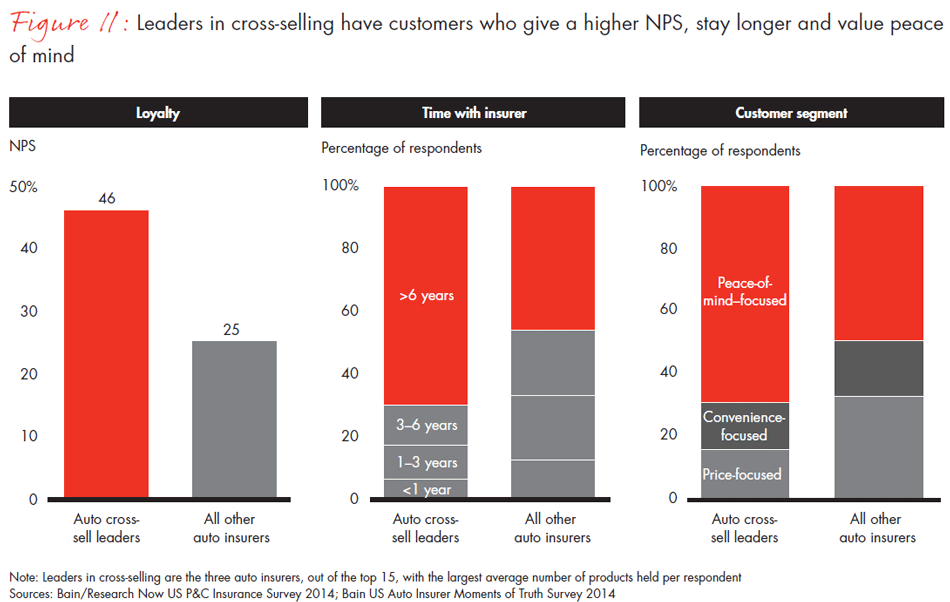
Leaders in cross-selling thus have selected customers with favorable demographics and also have demonstrated their prowess at earning loyalty through all channels.
Implications for carriers
Consumers have provided valuable information in this survey for insurers that are willing to listen and act in response. We see four practical implications for P&C carriers:
- Invest in “wowing” customers, not merely satisfying them, at key moments of truth
- Accelerate the shift to an omnichannel experience
- Refine marketing to be more selective in customer acquisition
- Blend product and pricing innovation to retain price-sensitive customers
Invest in “wowing” customers, not merely satisfying them, at key moments of truth. Given that our survey analysis clearly shows that creating promoters is more valuable than just avoiding detractors, insurers face the challenge of truly impressing their customers. And insurers need to choose the tactics best suited to their particular business.
For carriers that have positioned themselves as acquirers, good pricing alone is not sufficient to avoid mass defection by customers enticed by an even lower price. For retainers, it’s not sufficient to only deliver great service, because price stands as the biggest cause of defection; they may also have to raise their game in acquisition. “Wow” moments in acquisition typically involve convenience, like responding on the same day to a request for a price quote or providing proof of insurance through a smartphone.
To improve customers’ overall experience, some carriers move beyond the NPS metric to adopt a comprehensive approach called the Net Promoter SystemSM. Net Promoter® companies use regular customer feedback to understand what they are doing right and wrong. They loop the feedback quickly to their frontline employees, managers and senior executives. That allows employees to discover the root causes of problems as well as areas of distinction, which then enables them to take targeted actions. Over time, the accumulation of improvements serves to build a powerful competitive differentiation.
Loyalty leaders in insurance and other financial services sectors have taken a number of actions based on customer feedback. Charles Schwab has used these insights to invest in world-class call centers and considers them to be a competitive advantage instead of an expense. In P&C, claims handling is one area that offers a huge opportunity to gain customers’ trust and be valued. Some carriers in Germany have achieved that by developing a network of certified auto repair centers that provide higher-caliber repair at lower cost. Other carriers have presented attractive self-service options. Allstate, for example, allows customers in minor traffic accidents to use their smartphones to photograph the damage and upload the images using its QuickFoto Claim application. Allstate can settle those claims without inspecting the car itself and make direct deposits to the customers’ bank accounts. Several carriers use Enservio software to estimate the value of contents in a home, based on demographic and other information, allowing them to speed up the adjustment and negotiation process.
Accelerate the shift to an omnichannel experience. US insurance customers want to be able to use the channel that’s convenient to the moment, whether that’s a website, a mobile app, an in-person meeting or a video chat with an agent. For a given individual transaction with a carrier, 82% of survey respondents use a single channel. But across the full range of their transactions, 83% use multiple channels (see Figure 12).
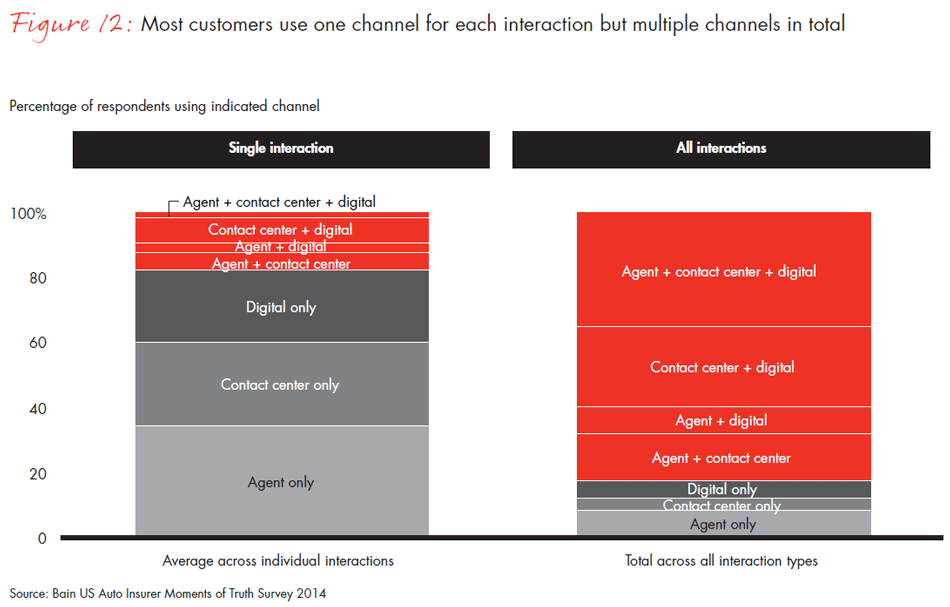
The expectation of using any channel pervades all customer segments, regardless of age, income or insurance needs. And over the next three to five years, the share of digitally active US insurance consumers is expected to increase substantially.
Transactions that attract more multichannel behavior, such as getting advice and a quote on a product or initially filing a claim, tend to be complex. These also happen to be interactions that have the biggest potential to delight customers. Multichannel users, moreover, give a higher NPS and buy more products, especially when compared with digital-only customers.
Insurers have made progress in the shift to an omnichannel world. USAA opened physical service centers at key locations after years of only serving customers through mail, phone and online channels. At these centers, USAA associates orient members to its insurance and banking services and technologies, show them how to complete routine transactions through various self-service channels, assist them with video conferencing and other technology for more complicated transactions, as well as provide advice.
Yet most carriers are still in their early days, with a long way to go toward engaging customers seamlessly across channels.
Coordination and collaboration across different functions within the organization are essential here. At many large old-line insurers, each function, such as underwriting, claims, finance, agents and the call center, makes its own investment decisions, which obstructs the goal of having a unified view of the customer. Another common problem involves spending heavily on IT systems but underinvesting in mechanisms to ensure that the customer interactions in one channel flow through to the other channels. Isolated, uncoordinated investments create major inefficiencies and make for a disjointed customer experience. These walls have to come down, and it usually requires cross-functional oversight by a senior executive. One major insurer, for instance, recently reorganized, so one executive oversees all of its service activities and another supervises the company’s acquisition activities, regardless of the channel.
Refine marketing to be more selective in customer acquisition. We’ve seen that insurers leading in acquisition spend heavily on advertising, focus their messages mainly on price and, as a result, attract more price-sensitive customers. For these leaders, like Progressive and GEICO, their acquisition engines are powered by a direct model that has structurally lower expense ratios than a traditional insurer has, allowing them to deliver on their low-price promise.
Attracting only price-sensitive customers will likely generate higher churn down the road, however, so these carriers will have to continually manage costs down to attract an outsize share of new customers and maintain their market position. As the arms race escalates, moreover, there may come a point of diminishing returns from advertising, so insurers would benefit from exploring how to make advertising and direct marketing more effective now.
For carriers that focus more on retention, the challenge is how to compete in this noisy environment. Traditional insurers like State Farm have significantly increased ad spending in recent years. Some are focusing their ad themes on peace of mind or convenience, supported by higher-touch service and advice, so that they don’t compete head-to-head on price.
These carriers could become even more discriminating in their marketing by shifting from a broadcast to a narrowcast mode, so they can target the most attractive segments. And they could intensify tailored marketing once the customer is on board, to provide information that customers value or reassure them that “we’ve got your back.” Advanced analytics can help to mine demographic, behavioral and other data to build predictive models that improve the accuracy of matching tailored products to target segments. USAA, for instance, mines customer data to inform its targeted marketing, which may be triggered by a life event, such as offering additional auto insurance to a family when a child turns age 16.
Whatever position an insurer decides to take—whether that’s low cost, convenience, peace of mind or something else— its operation must be structured to deliver on that promise in order to attract the right customers. And both acquisition and retention can benefit from optimizing the level and type of marketing to reach target segments most effectively.
Leading marketers in other industries like cable TV, telecommunications and retail do this as a matter of course. One powerful and sophisticated technique, called experimental design, allows marketers to exponentially increase the variables tested in a single campaign (product offers, messages, incentives, mail formats and so on), as well as test multiple offers in the market simultaneously. That allows the marketing organization to more quickly adjust messages and offers and, based on the responses, improve marketing effectiveness and the company’s overall economics.
Isolating the behavioral effect of each variable serves to confirm or refute the marketer’s hypothesis or the rules of thumb often used to support decisions. A “15% discount on car insurance” might seem like a winning promotion, but response rates will vary depending on the customer segment targeted, how the incentive is physically or digitally presented, and other factors.
When marketers learn exactly which variables entice consumers to act, response rates rise dramatically and overall return on marketing spending increases.
In Bain’s work with clients, we’ve seen how experimental design-based marketing campaigns increase consumer response rates by threefold to eightfold, adding hundreds of millions of dollars to the top and bottom lines. At a major cable company, for instance, the approach converted a much larger proportion of customers to high-value packages than had previously been achieved, which increased average revenue per user, a key metric in the industry, by 20%.
Blend product and pricing innovation to retain price-sensitive customers. Price matters a lot to P&C customers in the US, and its importance likely will endure as refinements to the Internet make comparison shopping easier. To retain a larger share of new customers, then, insurers will be pressed to step up their product and pricing innovations so customers have strong reasons to stay and even to buy more products.
Some innovations lean on price-related features. Nationwide’s Vanishing Deductible rewards safe driving, and many majors, including Allstate, offer “accident forgiveness,” where a higher-priced policy buys no increase in a premium after the first accident.
Other innovations stem from advances in digital technologies, notably in-vehicle telematics programs, which typically record driving behavior and use the data to inform the underwriting process. With the notable exception of Progressive’s Snapshot program, though, telematics has not yet achieved high penetration rates for most individual insurers, because some customers have been wary of the intrusion and most insurers have been reluctant to push the technology aggressively.
As mobile technology continues to advance rapidly and more people accept location tracking services, telematics seems certain to flourish. Start-ups already offer other telematics-based innovations. Two such examples are Admiral’s LittleBox in the UK and MetroMile’s launch, in several states, of an auto policy structured on price by the number of miles driven. Route-based pricing could soon appear, as evidence mounts that certain highways are statistically safer than city streets. As incumbents in other industries have discovered, it’s dangerous to ignore innovations brought to market by start-ups—consider how Airbnb has disrupted the lodging market.
Telematics raises a difficult choice for traditional insurers. When it reveals a safer-than-predicted driver, the company ought to lower the premium; for a riskier driver, it should raise the premium. An insurer may be reluctant to take those steps, but if it does not, a competitor certainly will.
• • •
For most P&C insurers, reigniting organic growth involves a choice between excelling in acquisition or retention. A select few might be able to outperform competitors on both, but that hasn’t happened to date. Both models, however, benefit from a dedicated focus on earning customers’ loyalty because of the value loyalty creates through greater retention, cross-selling and referrals. Listening closely to and acting on customer feedback is a proven route to making loyalty pay off.
For information about methodology, please see the PDF version of this report.
David Whelan and Sean O’Neill are partners with Bain & Company’s Global Financial Services practice. They are based in Chicago.
Net Promoter® and NPS® are registered trademarks of Bain & Company, Inc., Fred Reichheld and Satmetrix Systems, Inc.
Net Promoter SystemSM and Net Promoter ScoreSM are trademarks of Bain & Company, Inc., Fred Reichheld and Satmetrix Systems, Inc.













